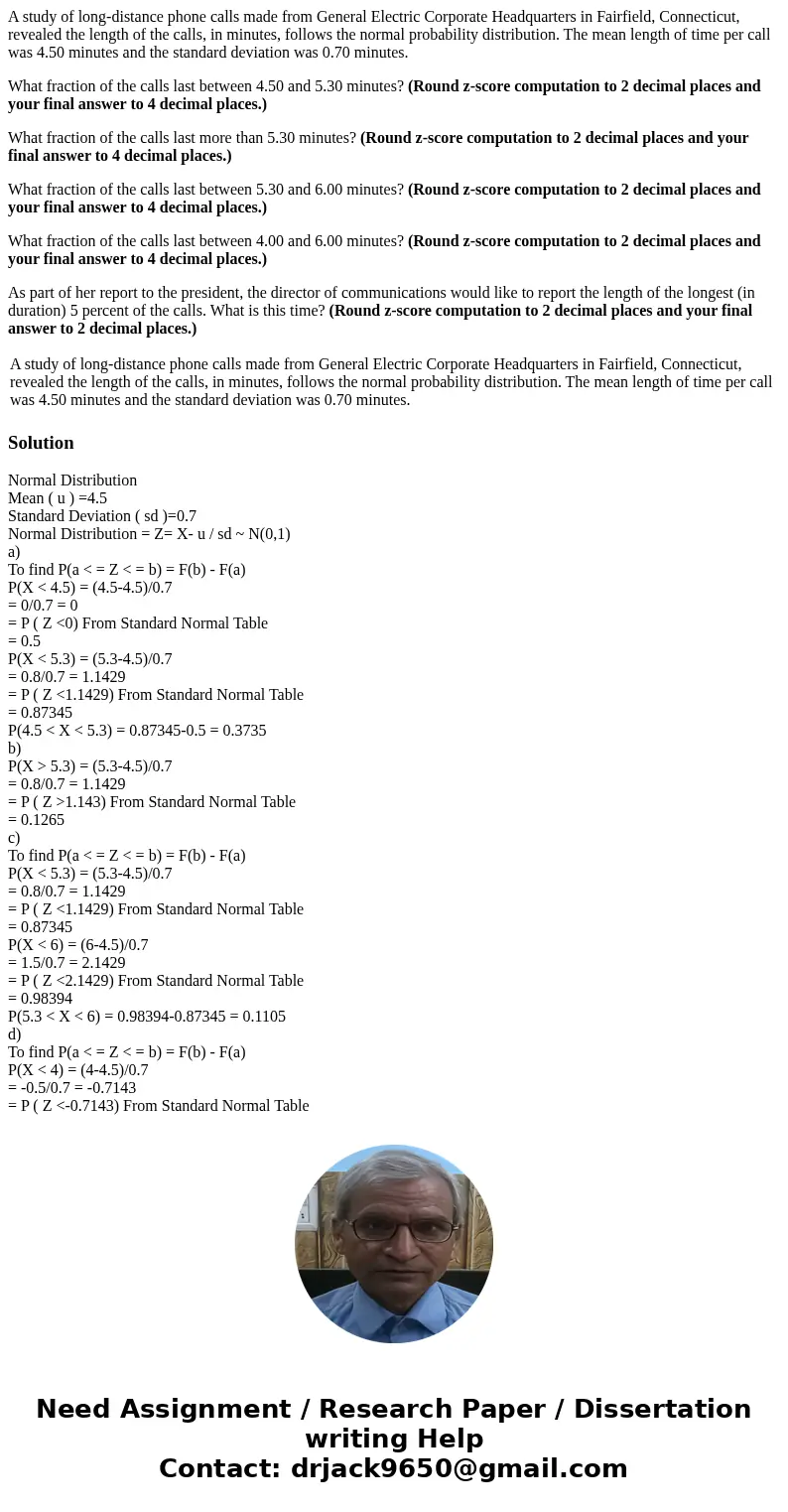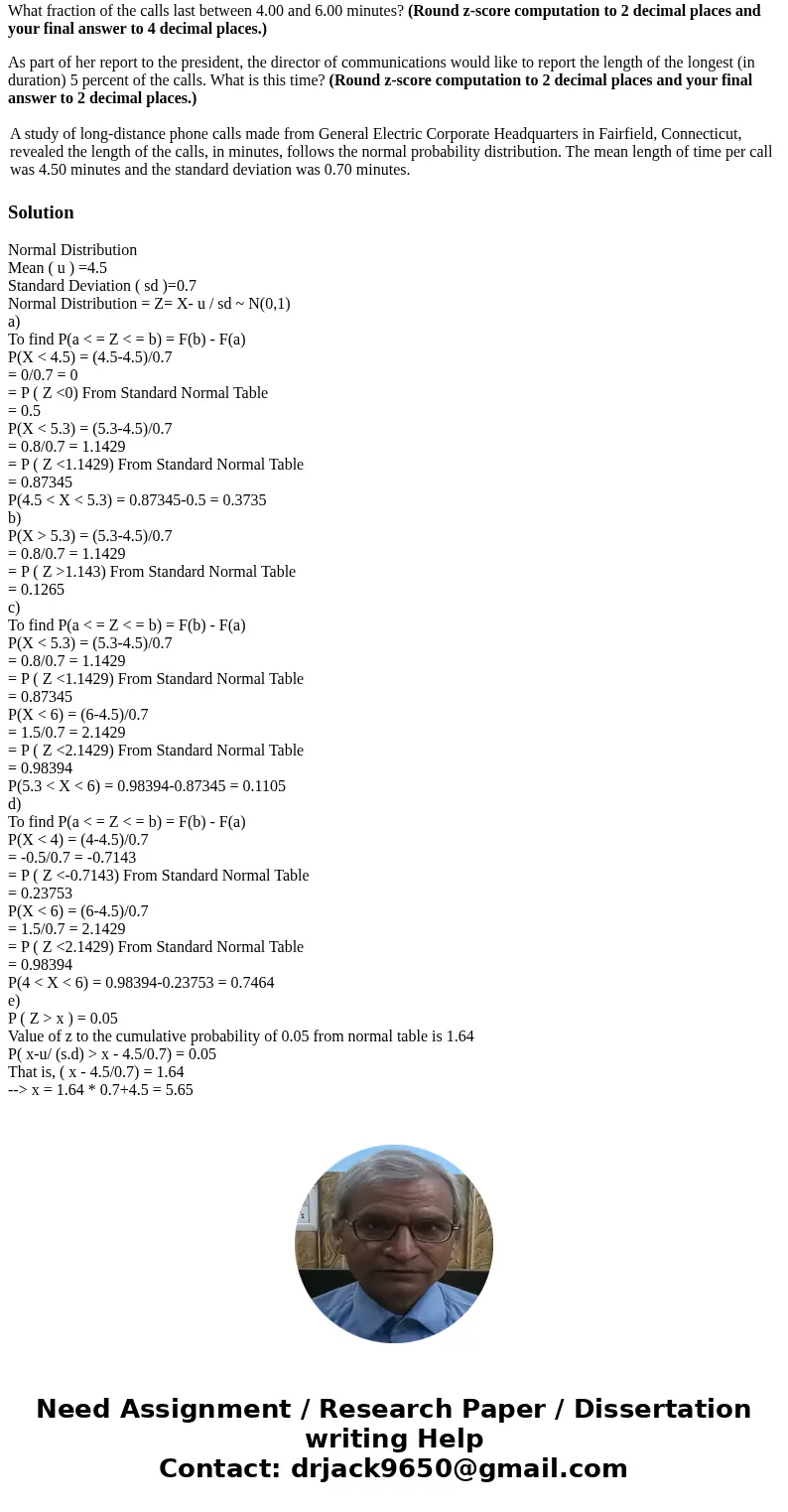A study of longdistance phone calls made from General Electr
A study of long-distance phone calls made from General Electric Corporate Headquarters in Fairfield, Connecticut, revealed the length of the calls, in minutes, follows the normal probability distribution. The mean length of time per call was 4.50 minutes and the standard deviation was 0.70 minutes.
What fraction of the calls last between 4.50 and 5.30 minutes? (Round z-score computation to 2 decimal places and your final answer to 4 decimal places.)
What fraction of the calls last more than 5.30 minutes? (Round z-score computation to 2 decimal places and your final answer to 4 decimal places.)
What fraction of the calls last between 5.30 and 6.00 minutes? (Round z-score computation to 2 decimal places and your final answer to 4 decimal places.)
What fraction of the calls last between 4.00 and 6.00 minutes? (Round z-score computation to 2 decimal places and your final answer to 4 decimal places.)
As part of her report to the president, the director of communications would like to report the length of the longest (in duration) 5 percent of the calls. What is this time? (Round z-score computation to 2 decimal places and your final answer to 2 decimal places.)
| A study of long-distance phone calls made from General Electric Corporate Headquarters in Fairfield, Connecticut, revealed the length of the calls, in minutes, follows the normal probability distribution. The mean length of time per call was 4.50 minutes and the standard deviation was 0.70 minutes. |
Solution
Normal Distribution
Mean ( u ) =4.5
Standard Deviation ( sd )=0.7
Normal Distribution = Z= X- u / sd ~ N(0,1)
a)
To find P(a < = Z < = b) = F(b) - F(a)
P(X < 4.5) = (4.5-4.5)/0.7
= 0/0.7 = 0
= P ( Z <0) From Standard Normal Table
= 0.5
P(X < 5.3) = (5.3-4.5)/0.7
= 0.8/0.7 = 1.1429
= P ( Z <1.1429) From Standard Normal Table
= 0.87345
P(4.5 < X < 5.3) = 0.87345-0.5 = 0.3735
b)
P(X > 5.3) = (5.3-4.5)/0.7
= 0.8/0.7 = 1.1429
= P ( Z >1.143) From Standard Normal Table
= 0.1265
c)
To find P(a < = Z < = b) = F(b) - F(a)
P(X < 5.3) = (5.3-4.5)/0.7
= 0.8/0.7 = 1.1429
= P ( Z <1.1429) From Standard Normal Table
= 0.87345
P(X < 6) = (6-4.5)/0.7
= 1.5/0.7 = 2.1429
= P ( Z <2.1429) From Standard Normal Table
= 0.98394
P(5.3 < X < 6) = 0.98394-0.87345 = 0.1105
d)
To find P(a < = Z < = b) = F(b) - F(a)
P(X < 4) = (4-4.5)/0.7
= -0.5/0.7 = -0.7143
= P ( Z <-0.7143) From Standard Normal Table
= 0.23753
P(X < 6) = (6-4.5)/0.7
= 1.5/0.7 = 2.1429
= P ( Z <2.1429) From Standard Normal Table
= 0.98394
P(4 < X < 6) = 0.98394-0.23753 = 0.7464
e)
P ( Z > x ) = 0.05
Value of z to the cumulative probability of 0.05 from normal table is 1.64
P( x-u/ (s.d) > x - 4.5/0.7) = 0.05
That is, ( x - 4.5/0.7) = 1.64
--> x = 1.64 * 0.7+4.5 = 5.65


 Homework Sourse
Homework Sourse